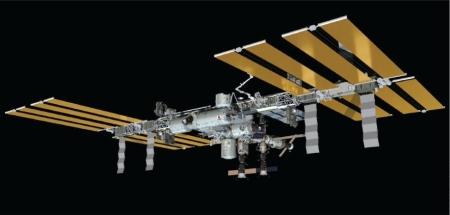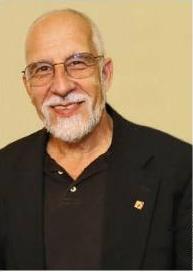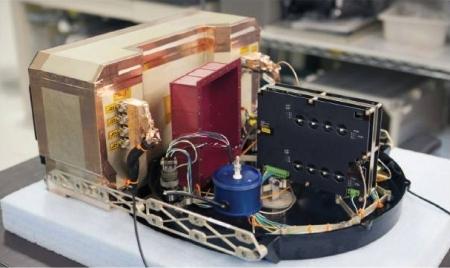Second Chance: Plant's return to space yields clues about how they sense gravity
(La Louisiane, p. 2-3, Summer 2014)

A Falcon rocket that was taking supplies to the International Space Station also carried the UL Lafayette biology experiment (NASA photo)
Dr. Karl Hasenstein hopes some of the answers to the scientific riddle of why plants grow up, while their roots grow down, rest in the palm of his hand. He's holding an amber-colored "plug" about the size and shape of a pencil eraser. Encapsulated inside the plug, which is composed primarily of resin, is a tiny root tip of Brassica rapa, or field mustard plant. The sliver of root, which resembles the stinger of a honey bee, is on of 80 such roots of a biology experiment that took place aboard the International Space Station earlier this year.

Dr. Karl Hasenstein (Amy Windsor photo)
Seeds of the fast-growing mustard plant were germinated inside a small, semi-autonomous device that's smaller than a shoebox. While in space, they were exposed to small amounts of water and infrared light needed to grow. They were also exposed to powerful magnetic fields.

The device that was sent into space contained tiny seeds from a mustard plant
The objective? To examine the effects of directional forces on plant growth in a weightless environment. "The work is important not just for plants but for everything, to understand what effects gravity has on individual cells," Hasenstein, a biology professor, explained in a recent interview.
The research is intended to shed light on an issue that's been debated for centuries. Scientists are unsure exactly how plants sense gravity. There are several prevailing theories.
One centers on starch grains inside plants, called amyloplasts. The tiny grains, which settle in the direction of gravity, are thought to provide growth cues. "They carry the signal," Hasenstein said. The experiment attempted to displace the particles, which are sensitive to magnetic gradients.
"We want to determine the distribution of these starch grains that are responsible -- we claim -- for sensing gravity," Hasenstein explained. "We try to understand it, because if we do, it could have applications for agriculture. We could reduce the damage of a storm blowing down sugarcane, for example."
The project was sent to the ISS in April aboard an unmanned Dragon capsule on a Falcon rocket, as part of a resupply mission.
The following month, the experiment returned to earth and splashed down off the California coast. Hasenstein and several graduate students retrieved the device containing the seeds from the Kennedy Space Center in Florida, where it hadbeen transported by plane and truck.
The researchers spent six long days carefully processing samples at the space center. In a series of steps, they extracted RNA and processed roots for microscopy before taking them back to the University.
"We got excellent germination on our roots," Hasenstein said, with a wide smile.
He had waited for more that 10 years for the chance to conduct his tests in space. In 2003, he had a similar experiment aboard the doomed Space Shuttle Columbia. The shuttle broke apart as it reentered the Earth's atmosphere, due to a piece of foam that broke off its exterior and struck the left wing.
Hasenstein lost much more than his experiment that day. Through his work, he had become friends with the seven crew members who perished. He had taught them how to conduct his experiment.
About six weeks after the Space Shuttle Columbia exploded above Texas, two small pieces of his experiment were recovered. But they provided no scientific data.
The scientist spent intervening years carrying on with his research, teaching, delving into other projects and trying to convince NASA officials of the benefits of relaunching the project, which has been funded with two NSF grants that total $800,000.
Once the project was given the go-ahead, Hasenstein spent about three years helping to redesign the experiment's hardware so it could operate with minimal human interaction.
One issue encountered during the launch and return of his experiment was a small leak inside the device that contained the seeds. Hasenstein said he is extremely grateful that it "did not affect our biology. It was a big relief to have this project come to fruition. This is a project that takes a lot of time, patience and money."
Altogether, counting research, teaching and his involvement with the two NASA launches, Hasenstein has spent a quarter of a century immersed in the study of gravitropism, the scientific term for how plants react to gravity.
Now, he is overseeing exhaustive genetic testing and analysis of the samples.
"We will be able to make our determinations and, hopefully, open the door for more questions," he said.
He plans to publish the results of the experiment once the research, which he anticipates will take between six and eight months, is complete. "I expect this to be complete by December, which would make a very nice Christmas present for me."
If the pressure on the cell membrane is what triggers the gravity response, the magnetic gradients should not have induced curvature. If the displacement of the starch grains is the gravity-sensing trigger, the plant roots should have curved away from the the magnetic gradient.
"If we know it's not sensitive to the displacement, then we don't have to go that way. We can look at something else. And that something else has to do with the cytoskeleton," the professor explained. The cytoskeleton contains a network of cellular components called microtubules and actin filaments, which mesh to form a structural network inside cells.
"This internal architecture is sensitive to movement and actually enables cells to transport things. We want to explore differences of the cytoskeleton as a result of space conditions."
Doctoral student Andrea Edge has spent more than three ears conducting a variety of research related to the project. In mid-July, she was conducting an intensive study of microtubules and actin filaments within root samples that were germinated aboard the ISS.
Edge is trying to determine if the organization of microtubules and actin filaments is different in roots grown in space, compared to those grown on Earth. "The research has important implications, because actin is thought to play a role in gravitropism," she explained.
The work is complex, tedious, intensive and important. It's also more than a little fun, she said. "It's very exciting. It' such a cool thing to get to work on a project that's been in space. Not many people get that opportunity."
